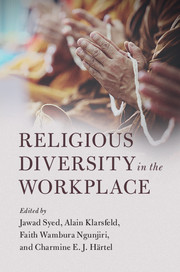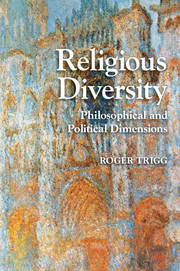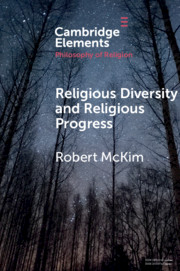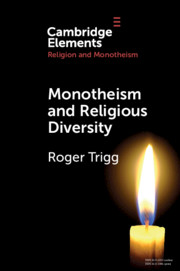Refine search
Actions for selected content:
59577 results for Religious Diversity in the Workplace
Title match

Religious Diversity in the Workplace
-
- Published online:
- 15 December 2017
- Print publication:
- 28 December 2017
14 - Organizational Approaches to Religious Diversity in the Workplace
- from Part IV - Organizational Approaches
-
-
- Book:
- Religious Diversity in the Workplace
- Published online:
- 15 December 2017
- Print publication:
- 28 December 2017, pp 389-415
-
- Chapter
- Export citation
2 - Religious Diversity, Identity, and Workplace Inclusion
- from Part I - General Frameworks and Sources of Reflection
-
-
- Book:
- Religious Diversity in the Workplace
- Published online:
- 15 December 2017
- Print publication:
- 28 December 2017, pp 60-80
-
- Chapter
- Export citation
12 - Religious Diversity in the Canadian Workplace: The Case of Muslims
- from Part III - Regional Approaches
-
-
- Book:
- Religious Diversity in the Workplace
- Published online:
- 15 December 2017
- Print publication:
- 28 December 2017, pp 331-353
-
- Chapter
- Export citation
24 - Cultural diversity in the workplace
- from Part IV - Applications
-
-
- Book:
- The Cambridge Handbook of Acculturation Psychology
- Published online:
- 05 April 2016
- Print publication:
- 08 April 2016, pp 483-503
-
- Chapter
- Export citation
36 - Diversity and Workplace Affect
- from Part VI - New Perspectives on Workplace Affect
-
-
- Book:
- The Cambridge Handbook of Workplace Affect
- Published online:
- 25 June 2020
- Print publication:
- 16 July 2020, pp 483-496
-
- Chapter
- Export citation
Religious Discrimination in the Workplace: An Emerging Hierarchy?
-
- Journal:
- Ecclesiastical Law Journal / Volume 12 / Issue 3 / September 2010
- Published online by Cambridge University Press:
- 20 August 2010, pp. 280-303
- Print publication:
- September 2010
-
- Article
- Export citation
4 - Diversity, Discrimination, and Harassment in the Workplace
-
- Book:
- Ethical Theory and Business
- Published online:
- 21 December 2019
- Print publication:
- 19 December 2019, pp 159-203
-
- Chapter
- Export citation
9 - Spirituality and Workplace Diversity Practices in Africa
- from Part III - Regional Approaches
-
-
- Book:
- Religious Diversity in the Workplace
- Published online:
- 15 December 2017
- Print publication:
- 28 December 2017, pp 223-263
-
- Chapter
- Export citation
7 - Reasonable Accommodations in a Psychosocial Diverse Workplace
-
- Book:
- Ableism at Work
- Published online:
- 06 August 2020
- Print publication:
- 19 December 2019, pp 122-152
-
- Chapter
- Export citation
Neurodiversity in the workplace: Considering neuroatypicality as a form of diversity
-
- Journal:
- Industrial and Organizational Psychology / Volume 16 / Issue 1 / March 2023
- Published online by Cambridge University Press:
- 09 March 2023, pp. 1-19
-
- Article
- Export citation
7 - Religious diversity
-
- Book:
- Herder on Humanity and Cultural Difference
- Published online:
- 03 May 2011
- Print publication:
- 21 April 2011, pp 219-247
-
- Chapter
- Export citation

Religious Diversity
- Philosophical and Political Dimensions
-
- Published online:
- 05 June 2014
- Print publication:
- 21 April 2014

Religious Diversity and Religious Progress
-
- Published online:
- 04 January 2019
- Print publication:
- 10 January 2019
-
- Element
- Export citation
Federal Labor Court strengthens religious freedom at the workplace
-
- Journal:
- German Law Journal / Volume 4 / Issue 6 / 01 June 2003
- Published online by Cambridge University Press:
- 06 March 2019, pp. 559-569
-
- Article
-
- You have access
- Export citation

Monotheism and Religious Diversity
-
- Published online:
- 07 August 2020
- Print publication:
- 03 September 2020
-
- Element
- Export citation
8 - Religious Diversity and Identity
-
- Book:
- Religious Diversity
- Published online:
- 05 June 2014
- Print publication:
- 21 April 2014, pp 132-150
-
- Chapter
- Export citation
18 - Religious Diversity in Singapore
- from SECTION 4 - THE TRANSFORMATION OF SOCIETY
-
-
- Book:
- Management of Success
- Published by:
- ISEAS–Yusof Ishak Institute
- Published online:
- 21 October 2015
- Print publication:
- 25 June 2010, pp 309-332
-
- Chapter
- Export citation
15 - Rahner and religious diversity
- from Part III - Conversations Ongoing
-
-
- Book:
- The Cambridge Companion to Karl Rahner
- Published online:
- 28 May 2006
- Print publication:
- 16 June 2005, pp 235-248
-
- Chapter
- Export citation
1 - The Challenge of Religious Diversity
-
- Book:
- Religious Diversity
- Published online:
- 05 June 2014
- Print publication:
- 21 April 2014, pp 4-22
-
- Chapter
- Export citation
